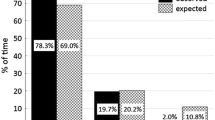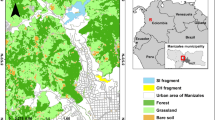Abstract
We carried out a 4-month census of primates in the Pando Department of northern Bolivia with special emphasis on Saguinus species. Contrary to a previous report by Izawa and Bejarano (1981), there was no evidence for the presence of the two populations of Saguinus mystax that they reported, or that Lagothrix occurs in the Pando. In addition, we found the distribution of Saguinus imperator to be more restricted than they suggested. We confirm the presence of Cebuella south of the Río Tahuamanu (cf. Brown and Rumiz, 1986) and report two new locations for Callimico goeldii. We present data on group sizes, habitat utilization, and locomotor behavior of the primates and compare them with previous studies in the Pando. Differences in body size, diet, foraging techniques, and vertical use of the forest appear to be key factors in both sympatry and in the formation of polyspecific associations.
Similar content being viewed by others
REFERENCES
Aquino, R., and Encarnación, F. (1994). Primates of Peru-Los Primates del PerÚ. Primate Rep. 40: 1-127.
Brown, A. D., and Rumiz, D. I. (1986). Distribución y conservación de los primates en Bolivia-estado actual de su conocimiento. In Mello, M. T. de (ed.), A Primatologia no Brasil-2, Sociedade Brasileira de Primatologia, Brasília, Brazil, pp. 335-363.
Buchanan-Smith, H. M. (1990). Polyspecific association of two tamarin species Saguinus labiatus and Saguinus fuscicollis in Bolivia. Am. J. Primatol. 22: 205-214.
Buchanan-Smith, H. M. (1991a). Encounters between neighbouring mixed species troops of tamarins in northern Bolivia. Primate Rep. 31: 95-99.
Buchanan-Smith H. M. (1991b). A field study of the red-bellied tamarin, Saguinus l. labiatus, in Bolivia. Int. J. Primatol. 12: 259-276.
Buchanan-Smith, H. M. (1991c). Field observations of Goeldi's monkey, Callimico goeldii, in northern Bolivia. Folia Primatol. 145: 1-4.
Buchanan-Smith, H. M. (1999). Tamarin polyspecific associations: Forest utilization and stability of mixed-species groups. Primates 40: 233-247.
Cabrera, A. (1957). Católogo de los mamíferos de América del Sur. Rev. Mus. Argentino Cienc. Nat. ''Bernardino Rivadavia'' 4: 1-307.
Cameron, R., and Buchanan-Smith, H. M. (1991-1992). Primates of the Pando, Bolivia. Primate Conserv. 12-13: 11-14.
Cameron, R., Wiltshire, C., Foley, C., Dougherty, N., Aramayo, X., and Rea, L. (1989). Goeldi's monkey and other primates of northern Bolivia. Primate Conserv. 10: 62-70.
Christen, A., and Geissmann, T. (1994). A primate survey in northern Bolivia, with special reference to Goeldi's monkey, Callimico goeldii. Int. J. Primatol. 15: 239-274.
Christen, A. (1999). Survey of Goeldi's monkeys (Callimico goeldii) in northern Bolivia. Folia Primatol. 70: 107-111.
Collins, A. C. (1999). Species status of the Colombian spider monkey, Ateles belzebuth hybridus. Neotrop. Primates 7(2): 39-41.
Cropp, S. J., Larson, A., and Cheverud, J. M. (1999). Historical biogeography of tamarins, genus Saguinus: Themolecular phylogenetic evidence. Am. J. Phys. Anthropol. 108: 65-89.
Cruz Lima, E. da. (1945). Mammals of Amazonia. General Introduction and Primates, Vol. 1 [English ed.], Contrib. Museu Paraense Emílio Goeldi de Historia Natural e Etnografia, Belém.
De Boer, L. E. M., and De Bruijn, M. (1990). Chromosomal distinction between red-faced and black-faced black spider monkeys (Ateles paniscus paniscus and A. p. chamek). Zoo Biol. 9: 307-316.
Encarnación, F., and Heymann, E. W. (1998). Body mass of wild Callimico goeldii. Folia Primatol. 69: 368-371.
Ferrari, S. F., Iwanaga, S., Ramos, E. M., Messias, M. R., Ramos, P. C. S., and Cruz Neto, E. H. da. (1999). Expansion of the known distribution of Goeldi's monkey (Callimico goeldii) in south-western Brazilian Amazonia. Folia Primatol. 70: 112-116.
Fleagle, J. G., and Mittermeier, R. A. (1980). Locomotor behavior, body size, and comparative ecology of seven Surinam monkeys. Am. J. Phys. Anthropol. 52: 301-314.
Fleagle, J. G., Mittermeier, R. A., and Skopec, A. L. (1981). Differential habitat use by Cebus apella and Saimiri sciureus in central Surinam. Primates 22: 361-367.
Fooden, J. (1963). A revision of the woolly monkey (genus Lagothrix). J. Mammal. 44: 213-217.
Ford, S. M., and Davis, L. C. (1992). Evolution of sexual dimorphism in body weight in platyrrhines. Am. J. Phys. Anthropol. 34: 221-244.
Freese, C. (1975). A census of non-human primates in Peru. In Primate Censusing Studies in Peru and Colombia, Pan American Health Organization, Washington, D.C., pp. 17-42.
Freese, C., Heltne, P., Castro, P. N., and Whitesides, G. (1982). Patterns and determinants of monkey densities in Peru and Bolivia with notes on distributions. Int. J. Primatol. 3: 53-90.
Froehlich, J. W., Supriatna, J., and Froehlich, P. H. (1991). Morphometric analyses of Ateles: Systematic and biogeographic implications. Am. J. Primatol. 25: 1-22.
Galetti, M., and Fernandez, J. C. (1998). Palm heart harvesting in the Brazilian Atlantic forest: Changes in industry structure and the illegal trade. J. Appl. Ecol. 35: 294-301.
Groves, C. P. (1993). Order Primates. In Wilson, D. E., and Reeder, D. M. (eds.), Mammal Species of the World: A Taxonomic and Geographic Reference, 2nd ed., Smithsonian Institution Press, Washington, D.C., pp. 243-277.
Hardie, S. M. (1998). Mixed-species tamarin groups (Saguinus fuscicollis and Saguinus labiatus) in northern Bolivia. Primate Rep. 50: 39-62.
Heltne, P. G., Freese, C. H., and Whitesides, G. (1975). A Field Survey of Non-human Primates Populations in Bolivia, Pan American Health Organisation, Washington, D.C.
Hershkovitz, P. (1949). Mammals of northern Colombia. Preliminary Report No. 4: Monkeys (Primates), with taxonomic revision of some forms. Proc. U.S. Nat. Mus. 98: 323-427.
Hershkovitz, P. (1977). Living NewWorld Monkeys (Platyrrhini); Vol 1, University of Chicago Press, Chicago.
Hershkovitz, P. (1979). The species of sakis, genus Pithecia (Cebidae, Primates), with notes on sexual dichromatism. Folia Primatol. 31: 1-22.
Hershkovitz, P. (1983). Two new species of night monkeys, genus Aotus (Cebidae, Platyrrhini): A preliminary report on Aotus taxonomy. Am. J. Primatol. 4: 209-243.
Hershkovitz, P. (1987). The taxonomy of South American sakis, genus Pithecia (Cebidae, Platyrrhini): A preliminary report and critical review with a description of a new species and a new subspecies. Am. J. Primatol. 12: 387-468.
Hershkovitz, P. (1990). Titis, New World Monkeys of the genus Callicebus (Cebidae, Platyrrhini): A preliminary taxonomic review. Fieldiana Zool. 55: 1-109.
Heymann, E. W. (1997). The relationship between body-size and mixed-species troops of tamarins (Saguinus spp.). Folia Primatol. 68: 287-295.
Hill, W. C. O. (1960). Primates. Comparative Anatomy and Taxonomy IV. Cebidae Part A, Edinburgh University Press, Edinburgh.
Hill, W. C. O. (1962). Primates. Comparative Anatomy and Taxonomy V. Cebidae Part B, Edinburgh University Press, Edinburgh.
Hinde, R. A. (1973). On the design of checksheets. Primates 14: 393-406.
Izawa, K. (1979). Studies on peculiar distribution pattern of Callimico. Kyoto Univ. Overseas Res. Rep. New World Monkeys 1979: 1-19.
Izawa, K., and Bejarano G. (1981). Distribution ranges and patterns of nonhuman primates in Western Pando, Bolivia. Kyoto Univ. Overseas Res. Rep. NewWorld Monkeys 1981: 1-12.
Kellogg, R., and Goldman, E. A. (1944). Review of the spider monkeys. Proc. U.S. Nat. Mus. 96: 1-45.
Medeiros, A. A. M. (1995). Cytogenetics, chromosomal evolution, radiation and speciation in spider monkeys. Neotrop. Primates 3(3): 89.
Minezawa, M., Harada, M., Jordan, O. C., and Valdivia Borda, J. C. (1985). Cytogenetics of the Bolivian endemic red howler monkeys (Alouatta seniculus sara): Accessory chromosomes and Y-autosome translocation related numerical variations. Kyoto Univ. Overseas Res. Rep. New World Monkeys 5: 7-16.
Mittermeier, R. A., and Van Roosmalen, M. G. M. (1981). Preliminary observations on habitat utilization and diet in eight Surinam monkeys. Folia Primatol. 36: 1-39.
Montes de Oca, I. (1989). Geografia y Recursos Naturales de Bolivia, 2nd ed., Ministerio de Educatión y Cultura, La Paz, Bolivia.
Napier, P. H. (1976). Catalogue of Primates in the British Museum (Natural History). Part 1: Families Callitrichidae and Cebidae, British Museum (Natural History), London.
Nickle, D. A., and Heymann E. W. (1996). Predation on Orthoptera and other orders of insects by tamarin monkeys, Saguinus mystax mystax and Saguinus fuscicollis nigrifrons (Primates: Callitrichidae), in north-eastern Peru. J. Zool. Lond. 239: 799-819.
Norconk, M. A. (1990). Mechanisms promoting stability in mixed Saguinus mystax and S. fuscicollis troops. Am. J. Primatol. 21: 159-170.
Peres, C. A. (1992a). Prey-capture benefits in a mixed-species group of Amazonian tamarins, Saguinus fuscicollis and S. mystax. Behav. Ecol. Sociobiol. 31: 339-347.
Peres, C. A. (1992b). Consequences of joint territoriality in a mixed-species group of tamarin monkeys. Behaviour 123: 220-246.
Peres C. A. (1993). Notes on the primates of the Juruá river, western Brazilian Amazonia. Folia Primatol. 61: 97-103.
Podolsky, R. D. (1990). Effects of mixed-species association on resource use by Saimiri sciureus and Cebus apella. Am. J. Primatol. 21: 147-158.
Pook, A. G., and Pook, G. (1979). A field study on the status and socio-ecology of the Goeldi's monkey (Callimico goeldii) and other primates in northern Bolivia. Unpublished Report for the New York Zoological Society, Bronx Zoo, New York.
Pook, A. G., and Pook, G. (1982). Polyspecific association between Saguinus fuscicollis, Saguinus labiatus, Callimico goeldii and other primates in North Western Bolivia. Folia Primatol. 38: 196-216.
Rylands, A. B. (1987). Primate communities in Amazonian forests: Their habitats and food resources. Experientia 43: 265-279.
Rylands, A. B., Coimbra-Filho, A. F., and Mittermeier, R. A. (1993). Systematics, geographic distribution, and some notes on the conservation status of the Callitrichidae. In Rylands, A. B. (ed.), Marmosets and Tamarins: Systematics, Behaviour, and Ecology, Oxford University Press, Oxford, pp. 11-77.
Rylands, A. B., Mittermeier, R. A., and Rodríguez Luna, E. (1995). A species list for the New World primates (Platyrrhini): Distribution by country, endemism, and conservation status according to the Mace-Lande system. Neotrop. Primates 3(Suppl.): 113-160.
Southwick, C. H., and Cadigan, F. C. (1972). Population studies of Malaysian primates.Primates 13: 1-18.
Stanyon, R., Tofanelli, S., Morescalchi, M. A., Agoramoorthy, G., Ryder, O. A., and Wienberg, J. (1995). Cytogenetic analysis shows extensive geometric rearrangements between red howler (Alouatta seniculus Linnaeus) subspecies. Am. J. Primatol. 35: 171-183.
Tarifa, T. (1996). Mamiferos. In Ergueta S. P., and Morales C. de (eds.), Libro Rojo de los Vertebrados de Bolivia, Centro de Datos para la Conservación, La Paz, Bolivia, pp. 165-264.
Terborgh J. (1983). Five New World Primates: A Study of Comparative Ecology. Princeton University Press, Princeton, New Jersey.
Van Roosmalen, M. G. M., and Van Roosmalen, T. (1997). An eastern range extension of the geographical range of the pygmy marmoset, Cebuella pygmaea. Neotrop. Primates 5(1): 3-6.
Wright, P. C. (1984). Biparental care in A. trivirgatus and C. moloch. In M. F. Small (ed.), Female Primates, Alan R. Liss, New York, pp. 59-76.
Yoneda, M. (1984). Comparative studies on vertical separation, foraging behaviour and travelling mode of saddle back tamarins (Saguinus fuscicollis) and red-chested moustached tamarins (Saguinus labiatus) in northern Bolivia. Primates 25: 414-422.
Author information
Authors and Affiliations
Rights and permissions
About this article
Cite this article
Buchanan-Smith, H.M., Hardie, S.M., Caceres, C. et al. Distribution and Forest Utilization of Saguinus and Other Primates of the Pando Department, Northern Bolivia. International Journal of Primatology 21, 353–379 (2000). https://doi.org/10.1023/A:1005483601403
Issue Date:
DOI: https://doi.org/10.1023/A:1005483601403




